After the dissolution of the Dutch studio LUST, founded in 1996, designer Michèle Champagne and editor Greg J. Smith reminded themselves, in an epistolary form, of the adventure of Jeroen Barendse, Thomas Castro and Dimitri Nieuwenhuizen. Combining initiated projects and commissions from major cultural institutions, LUST has covered the world with unique works combining digital and physical environments.
Michèle Champagne,
Montreal,
October 17th, 2017
It was only a few weeks ago that I read with sadness that LUST were opbreken. The closing of LUST triggered memories of Dimitri as well as distant memories of when I first encountered the studio. Here is an idea: let’s write about LUST applications, exhibitions, installations, maps, publications, projections, videos, visualizations, websites, and workshops, no matter how big or small. The idea is not to survey everything, but rather to highlight the generative and media madness they brought to design, art, and architecture. Let’s remember what LUST did and how they did it. Let’s remember why we think that was important.
The moment I discovered LUST is still sharp in my memory and it was regarding something wonderfully banal—an iPad application for Items, 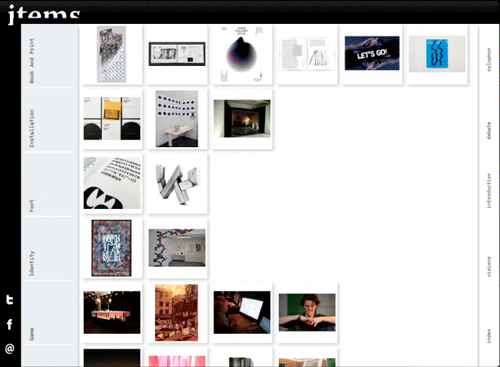 a lively and critical but now defunct Dutch design magazine edited by Max Bruinsma. The year was 2011. I was living in Amsterdam and had come down to Eindhoven for Dutch Design Week. Within the concrete cave of MU Artspace, Bruinsma unveiled Items’ Dutch Design Graduates issue along with its inaugural iPad edition.
a lively and critical but now defunct Dutch design magazine edited by Max Bruinsma. The year was 2011. I was living in Amsterdam and had come down to Eindhoven for Dutch Design Week. Within the concrete cave of MU Artspace, Bruinsma unveiled Items’ Dutch Design Graduates issue along with its inaugural iPad edition.
Bruinsma and I had met through the Sandberg Instituut so he let me fiddle with his tablet after the launch. The application enabled readers to select, order, and reorder graduation projects by designer, school, discipline, or medium. The images were alive. The texts, however long or short, were curious and well-crafted. The typesetting was stark and plotted with Nitti, a quirky monospaced sans-serif inspired by 19th-century British Grotesques and laced with hints of typewriting. However expressive and eclectic the graduation projects may have been, the typography gave them an air of serious business. Nitti and its crisp typesetting were too interesting to be dismissed as merely austere: they were more like charismatic filing instruments that click and grind as gears spin and drawers pop.
The Items application was a strict rendition of the now common card-based interface, but at the time, it was refreshing.33 Benedict Evans, “Twitter, Canvases and Cards,” 18 June 2013: http://b-o.fr/evans It still is today. It lacked the trappings of most “digital magazines”: you know what I mean—pages locked behind glossy little rectangles, organized according to old print sections and with similar layouts. Think of how widely Adobe’s Digital Publishing Suite has been used to shape digital magazines as identical to their print siblings as possible.44 “Transforming the Magazine Experience with WIRED,” http://b-o.fr/wired Nevertheless, LUST’s iPad application was important because it introduced me to their other work. Once you’ve spotted LUST in the corner of your eye, they march onto center stage and there’s a vast playlist to be getting on with. In time, I read up on Posterwall for the 21stCentury (2008–2012), RGB City (2009), Urban Echo (2010–2014), Type/Dynamics (2013), and Death in Venice (2014).
The discovery hit home because I had worked with Mediamatic upon moving to Amsterdam in 2009.1010 Mediamatic Foundation (1983) is a cross-media magazine, social network, and new media art organization based in Amsterdam (www.mediamatic.net). Mediamatic is a cross-media magazine, social network, and new media foundation whose interests, methods, and disciplines overlaps with LUST’s. To wit, giving research the space it requires, allowing concepts to direct esthetics, exploring code creatively and experimenting with ordering, re-ordering, and representing data and information in multiple ways. This kind of method means, at least at first, that you have no idea if the outcome will be a print catalogue or a street installation rife with motion sensors. You have no idea which formal cues—whether visual, audio, or spacial—will emerge because working with concepts and digital media allows data and information to be displayed in different ways and without predetermined styles.
Death in Venice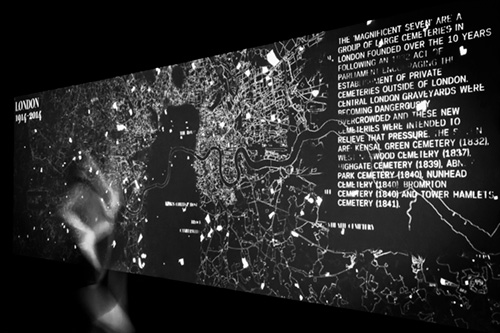
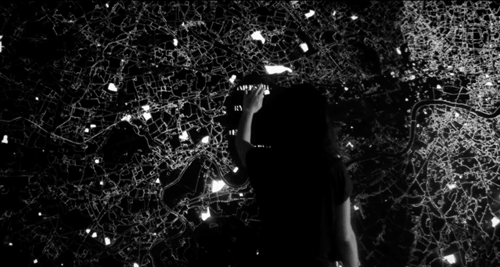 was a good example. In 2014, I was back in Toronto but noticed LUST was unofficially exhibiting at the Venice Architecture Biennale. Curated and co-designed by Alison Killing and Ania Molenda, the independent exhibition was a sensitive foray into the relationship between modern architecture and death in Britain since 1914. Since the dynamics of death and dying no longer dominated the design and architecture record, Death in Venice was important because it chronicled the history of places that dealt with a solemn yet significant part of life and that still influenced architecture as a discipline. The exhibition was also noteworthy because it used whatever media was necessary to craft that narrative.
was a good example. In 2014, I was back in Toronto but noticed LUST was unofficially exhibiting at the Venice Architecture Biennale. Curated and co-designed by Alison Killing and Ania Molenda, the independent exhibition was a sensitive foray into the relationship between modern architecture and death in Britain since 1914. Since the dynamics of death and dying no longer dominated the design and architecture record, Death in Venice was important because it chronicled the history of places that dealt with a solemn yet significant part of life and that still influenced architecture as a discipline. The exhibition was also noteworthy because it used whatever media was necessary to craft that narrative.
In one space, an interactive map of London’s hospitals, chapels, cemeteries, and crematoria dominated a wall. With the wave of an arm, visitors could wipe away layers of information and reveal others which then vanished with time. The room’s esthetic was conceptually rooted in its context: dark and mysterious, things would appear and then disappear. For guiding eyes through hidden cartographies, the wall offered crisp white lines and sparkling texts. The second room was equally dark. There, visitors were followed by a generative sound, a spotlight, and a meandering fog that came and went upon entering and exiting. A third room was brightly lit and filled with black CNC-milled infographic boards and piles of printed postcards displaying research specimens.
Whereas the iPad application for Items was bright, minimal, and bureaucratic, Death in Venice was somber, layered, and magical. The exhibition was like one of those medieval cosmology guides to the Ptolemaic universe, in which the milky trail of glittery bits leaves a whimsical impression of something long gone. The space was filled with the maps, spaces, and images of death, where hopes are dashed, happiness is found, bodies are laid, and final kisses made. The exhibition is extremely analog and extremely digital. It is impervious to the physical-virtual binary. This makes LUST’s enterprise both a marvelous freak of graphic design as well as a summoner of our greatest hopes for rising above media and disciplinary categories.
LUST lacked visual consistency but they had a consistent esthetic: they were concerned with a work’s ability to capture us in an experience, to anchor us in a moment that brings our emotions and our senses alive.LUST were obsessed with data, information, and computation, but they never forgot about us mortals and they were dedicated to an uncommon vision of narrative, form, and beauty. LUST embraced conceptual attitudes, generative outcomes, and renounced a fussy, too-perfect finish.
Do you remember the first time you came across LUST?
Greg J. Smith,
Hamilton,
October 22th, 2017
I vividly remember my initial encounter with LUST’s work. Like many people in North America, my introduction to their practice was in 2010, via Form+Code in Design, Art, and Architecture.1111 Casey Reas, Chandler McWilliams, LUST, Form+Code in Design, Art, and Architecture (New York City: Princeton Architectural Press, 2010). 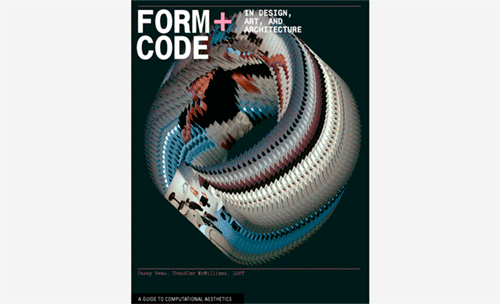 A collaboration between Casey Reas,1212 Casey Reas is a software artist and co-instigator of Processing (2001). Chandler McWilliams,1313 Chandler McWilliams is an artist living and working in Los Angeles. His practice engages sculpture, text, and performance to cope with ideas of ethics, space, perception, and thought. and LUST, the book chronicled the emerging computational design scene with some seriously ambitious curation. Actually I probably shouldn’t say ‘emerging’—even a decade ago people had been making art with machines for forty years. What Form+Code did that was so revelatory was shine a light on vital (but niche) contemporary practitioners and identify connections between them and more historicized movements like Fluxus, aleatoric music, and conceptual art. I remember gushing over one such historical vector that linked Ivan Sutherland’s 1963 proto-CAD software Sketchpad and digital fabrication when I reviewed the book for Rhizome.org:
A collaboration between Casey Reas,1212 Casey Reas is a software artist and co-instigator of Processing (2001). Chandler McWilliams,1313 Chandler McWilliams is an artist living and working in Los Angeles. His practice engages sculpture, text, and performance to cope with ideas of ethics, space, perception, and thought. and LUST, the book chronicled the emerging computational design scene with some seriously ambitious curation. Actually I probably shouldn’t say ‘emerging’—even a decade ago people had been making art with machines for forty years. What Form+Code did that was so revelatory was shine a light on vital (but niche) contemporary practitioners and identify connections between them and more historicized movements like Fluxus, aleatoric music, and conceptual art. I remember gushing over one such historical vector that linked Ivan Sutherland’s 1963 proto-CAD software Sketchpad and digital fabrication when I reviewed the book for Rhizome.org:
Form+Code is full of these compact histories, and each is tastefully illustrated with related contemporary projects and precedents and predecessors. Op-artist Bridget Riley’s Polarity (1964) sits in a spread beside Martin Wattenberg’s music visualization The Shape of Song (2001), highlighting the similarities in the graphic language of luminaries from two distinct generations.1616 http://b-o.fr/rhizome
The book was a beacon, and I remember being so excited to see it published by Princeton Architectural Press alongside classroom-oriented graphic design texts by author and design critic Ellen Lupton. Surely this book would reach design students worldwide and influence thousands of careers, I thought at the time; and it did. And LUST played a part in that moment. They weren’t in the book as a featured practice—they helped construct the conceptual scaffolding into which all these creative practices and historical movements were plugged.
When LUST announced they were closing up shop, I was of course awed that they had a twenty-year run. Now, I feel like the design world is operating with one less vital outpost. This tangible sense of loss evokes broader thoughts about resilience and sustainability. While I won’t dwell on how unusual it is for an experimental studio that does commercial work to be active for more than a decade, I can’t help but notice how frequently similar operations shutter after only a few years of practice (RIP Berg, the Office for Creative Research, Urbanscale, Hide&Seek, and countless others). When I look at a studio like LUST ;the work they did, the size of their team—I can only scratch my head and ask: how did they make that work?
M. C.,
Montreal,
October 25th, 2017
LUST had a sister and her name was LUSTlab. Born in 2010, the lab became LUST’s conduit for experimentation, working with or without clients or clear outcomes. More importantly, as Dimitri often put it, LUSTlab reached across “design, science, and architecture.” That gave us Beaufort’s Poetry (2015),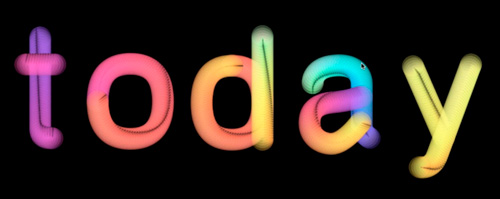 a permanent typography and light installation at Forum in The Hague that translates weather data into generative poetry. The lighting in the space and the color of the typographic projection reflect changes in wind speed and direction. What you get, basically, is a giant literary weather vane that explodes from a glass-laden lobby onto the public square before it, turning a private interior into a shared city space.
a permanent typography and light installation at Forum in The Hague that translates weather data into generative poetry. The lighting in the space and the color of the typographic projection reflect changes in wind speed and direction. What you get, basically, is a giant literary weather vane that explodes from a glass-laden lobby onto the public square before it, turning a private interior into a shared city space.
In this way, LUSTlab is akin to AMO,1717 “The Origins of OMA/AMO,” http://b-o.fr/omaamo the research and media arm of the Rotterdam-based Office for Metropolitan Architecture (OMA) founded by the architects Rem Koolhaas, Ellen van Loon, Reinier de Graaf, among others. I have known about AMO ever since I picked up their book Content,1818 Content, Rem Koolhaas and Brendan McGetrick ed., (Cologne: Taschen, 2004). a cheap and sassy follow-up to S, M, L, XL,1919 Rem Koolhaas and Bruce Mau, S, M, L, XL, Jennifer Sigler, ed. (New York City: The Monachelli Press, 1998). but it was not until the exhibition The Other Architect at the Canadian Centre for Architecture in Montréal, that I took a closer look. On display were dozens of anti-disciplinary groups—from AMO to AnyOne Corporation, Art Net, Delos Symposion, Forensic Architecture, and Atelier de Recherche et d’Action Urbaines—conjuring up new ways of thinking and making outside of traditional studio models. These groups are also vital (but niche). LUSTlab and AMO differ in many ways, but they both act as experimental mirrors for their studios. In this relationship, research is not approached the way it so often is, as a “research and development” platitude, where ‘thinking’ is an ulterior motive for ‘making’ something—like self-promotional moves or future client work. Instead, LUSTlab operates with the primary motive of reflection and discovery. “It is a mirror after all,” as Dimitri once reminded me.
Institutional support also plays a role in nurturing experimentation. Not to diminish the efforts of LUST, but we cannot talk about them without bringing up the Netherlands. My Dutch friends would disagree, citing endless cuts to state funding as the result of austerity and as proof of a return to the Dark Ages, but design remains an important part of Dutch society: its cultural identity, economic activity, and run-of-the-mill transportation infrastructure. Even the most basic Dutch street design bears witness to this reality. As designer and art director Brian Morgan once put it, design in the Netherlands is “part of the plumbing.” Whether or not Dutch design now rests on its laurels is an important question, but we cannot ignore the fact that there were laurels to begin with and that studios like LUST sustained their song for so long. Dutch institutions do not guarantee experimentation but they are more likely to support it, by including design, architecture, and creative coding in the cultural cocktail typically reserved for art bars.2222 Mienke Simon Thomas, Dutch Design: a History (Chicago: University of Chicago Press, 2008).
G. S.,
Hamilton,
October 28th, 2017
Responding to Dimitri’s definition of LUSTlab as a “mirror studio,” I think many studios are a bit ‘Jeckyl and Hyde’ in terms of the contrast between prestige projects and the work that pays the bills; the idea of formalizing a literal better half that remains unmoved by the trade winds is commendable.
Regardless of what ‘side’ of the studio spawned it, my favorite project of theirs was probably Type/Dynamics,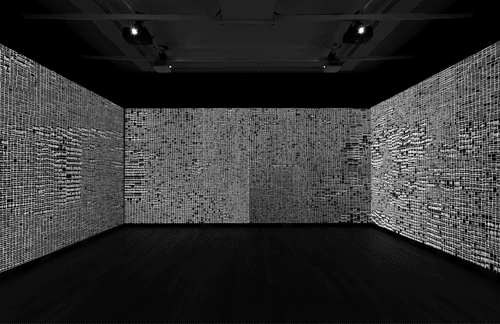 an exhibition hosted at the Stedelijk Museum in 2013–2014. I’m not going to pretend that this opinion emerges from a comprehensive understanding of LUST’s entire work—it’s instinctive—and I never got to experience Type/Dynamics in the flesh, but I remember when its documentation was published. Here was this immersive typographic experiment that made graphic design truly environmental. It also made the environment typographic by taking the organizational logic of the ubiquitous image grid and transposing photographs with words. It was dense, messy, and overwhelming. A visitor to the installation basically has an embodied metadata experience by way of complete immersion in a sea of information about rotating sites of interest ;a visual expression of the ADHD zeitgeist of our current media landscape. The fact that the project was a savvy homage to Dutch designer Jurriaan Schrofer2323 Jurriaan Schrofer (1926–1990) was a Dutch art director, art manager, educator, and graphic designer. Schrofer designed Forum magazine for the PTT (Dutch national post office), Stedelijk Museum, and a partner at Total Design in Amsterdam. was icing on the cake.
an exhibition hosted at the Stedelijk Museum in 2013–2014. I’m not going to pretend that this opinion emerges from a comprehensive understanding of LUST’s entire work—it’s instinctive—and I never got to experience Type/Dynamics in the flesh, but I remember when its documentation was published. Here was this immersive typographic experiment that made graphic design truly environmental. It also made the environment typographic by taking the organizational logic of the ubiquitous image grid and transposing photographs with words. It was dense, messy, and overwhelming. A visitor to the installation basically has an embodied metadata experience by way of complete immersion in a sea of information about rotating sites of interest ;a visual expression of the ADHD zeitgeist of our current media landscape. The fact that the project was a savvy homage to Dutch designer Jurriaan Schrofer2323 Jurriaan Schrofer (1926–1990) was a Dutch art director, art manager, educator, and graphic designer. Schrofer designed Forum magazine for the PTT (Dutch national post office), Stedelijk Museum, and a partner at Total Design in Amsterdam. was icing on the cake.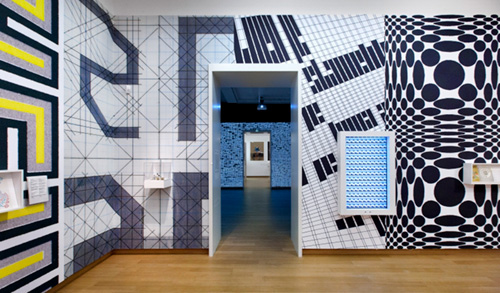
I also feel an affinity for Hyperlocator I & II (2014–2016)2424 LUSTlab, Hyperlocator I and II is an interactive photography installation that examines the reliability of digital and physical sensory impressions and experiences. (The Hague: Off Senses | Future Sense Festival at Vrije Academie’s Gemak Center [now closed] 2014–2016).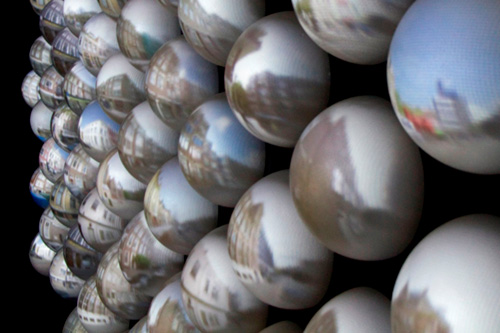 and their anthropod eye(s) on the city. When they enter these installations, viewers are confronted with a haphazard array of spherical lenses, each offering a fisheye lens-like window of a specific Google Street View. These matrices offer a kind of pluralistic, distributed vision that is a welcome counterpoint to the ubiquitous omniscience of satellite photography. They speak to manyeyes and vast systems of seeing. Both of these iterative works and Type/Dynamics were universal solvents, they decomposed places and perspectives while offering bottom-up alternatives to the totalizing views and queries for which we queue up via Google and related services every day. Both works were quietly subversive, so much more so than the noisy environments for which they might be mistaken.
and their anthropod eye(s) on the city. When they enter these installations, viewers are confronted with a haphazard array of spherical lenses, each offering a fisheye lens-like window of a specific Google Street View. These matrices offer a kind of pluralistic, distributed vision that is a welcome counterpoint to the ubiquitous omniscience of satellite photography. They speak to manyeyes and vast systems of seeing. Both of these iterative works and Type/Dynamics were universal solvents, they decomposed places and perspectives while offering bottom-up alternatives to the totalizing views and queries for which we queue up via Google and related services every day. Both works were quietly subversive, so much more so than the noisy environments for which they might be mistaken.
M. C.,
Montreal,
November 4th, 2017
When it comes to LUST, there is an endless playlist of great projects and countless memories to share. Who knows which institution will revive the memory of LUST. The Stedelijk Museum would be smart to step up and I would love to see them collaborate
with researchers at the Canadian Center for Architecture in Montreal or the Walker Art Center in Minneapolis. Dreams await.
G. S.,
Pittsburgh,
November 7th, 2017
I too hope to see what retrospectives emerge in the coming years. Until then, I find some small solace that LUST received the BNO Piet Zwart Award in recognition of their vast, spirited body of work. That award is a fantastic exclamation point and it sits triumphantly at the end of the sentence announcing their closure!